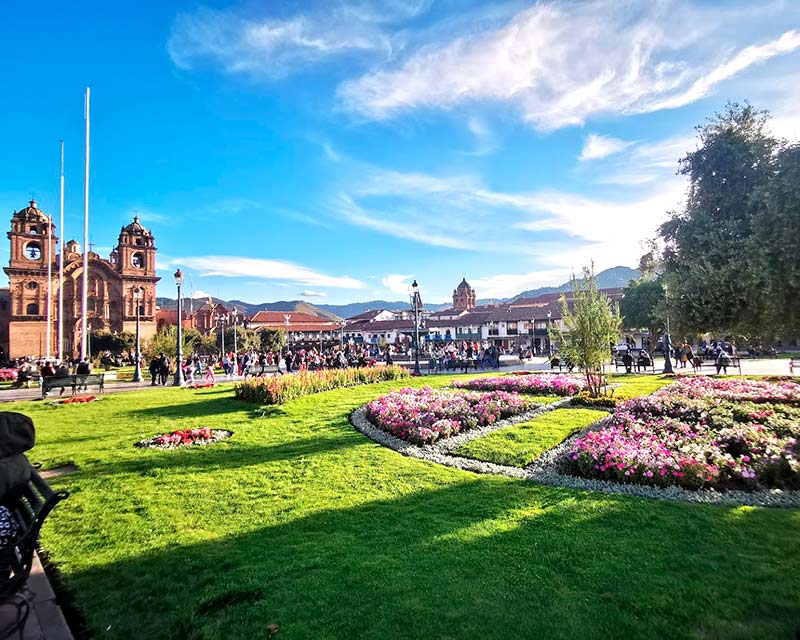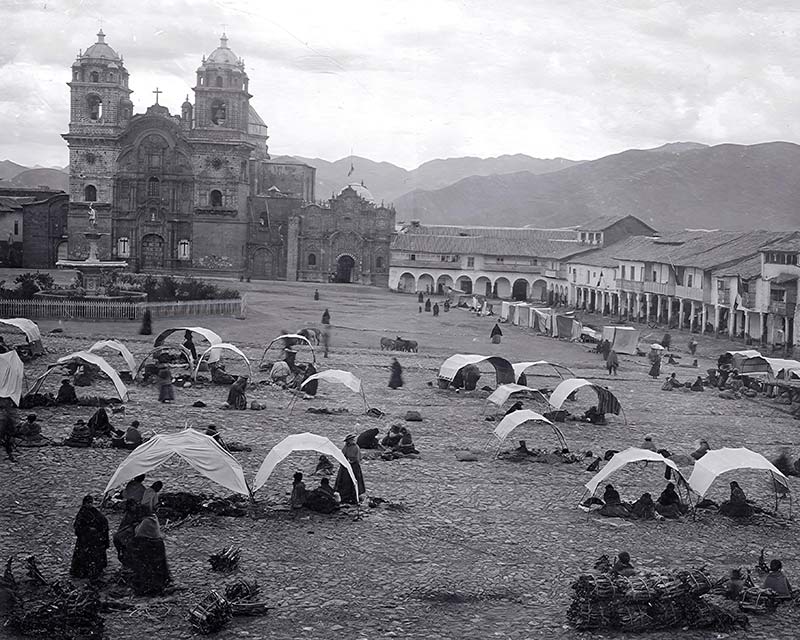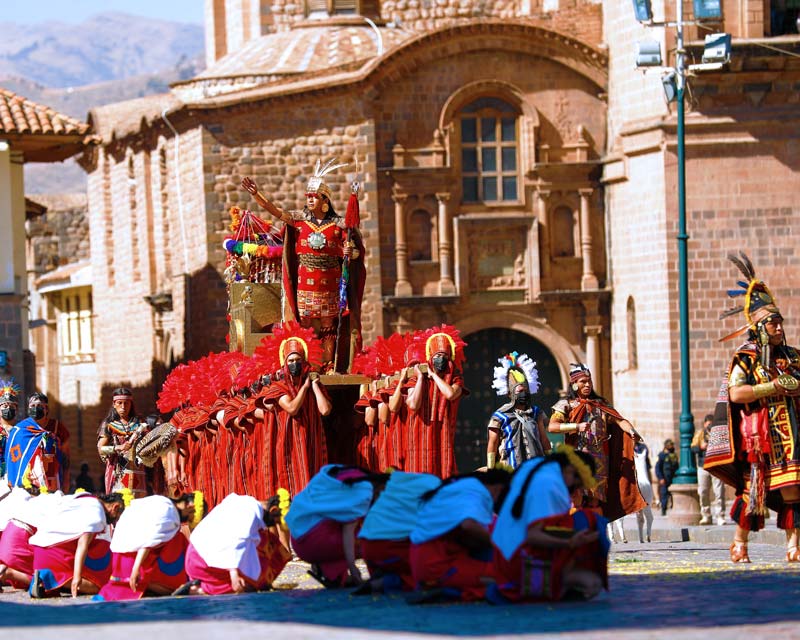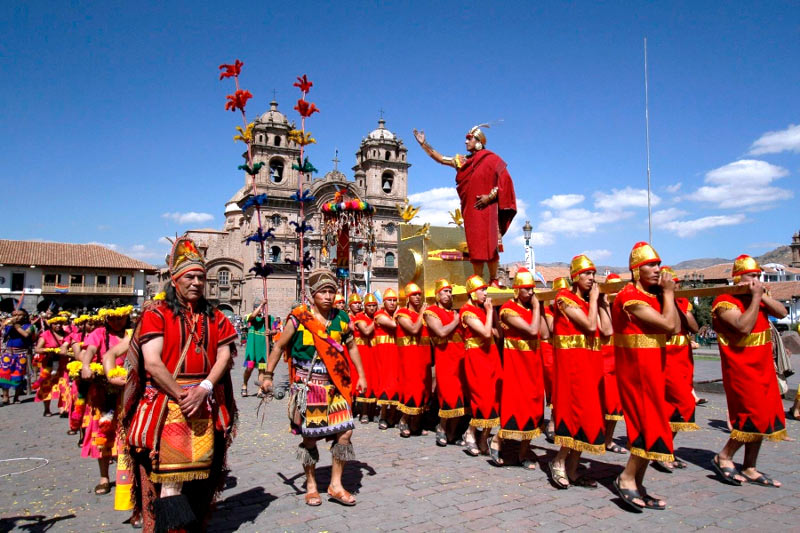The Inti Raymi in the Main Square of Cusco
Inti Raymi is celebrated every year on June 24. This Cusco festival has as its great event the presentation of three performances that symbolize the Inca sun festival. The first takes place at 9 in the morning at the Coricancha temple. The second, at 11 in the morning, in the Main Square. The third, at 2 in the afternoon, in the Sacsayhuamán fortress. Learn about the event in the historic Main Square of Cusco, a place of great importance since Inca times.
Content:
The Main Square of Cusco

The Main Square of Cusco is the central point of tourism in the city of Cusco. It is one of the most beautiful squares in Peru, one of the largest and, without a doubt, one of the most visited by visitors from all over the world.
The also called Plaza Mayor of Cusco has an area of 28,728 square meters. However, its current form was transformed during the colonial era (16th century) as its origins date back to the Inca era. Then the plaza was called Huacaypata. It is presumed that its foundation was in the 11th century, during the government of the legendary Manco Cápac.
Since Inca times, the Main Square of Cusco had the function of the main center for civic, military and even religious events. Today, after more than nine centuries, the square continues to serve as the main civic center since the most important ceremonies in the festivities of Cusco are held there. Even every June 24, one of the Inti Raymi shows takes place there. The other two are held in the Coricancha temple and the Sacsayhuamán fortress.
The current shape of the Main Square – and the location of its temples and palaces around it – was decided during the Spanish founding in 1534 (on March 23 by ruler Francisco Pizarro ). Right in front, and replacing the Inca palaces and temples, the plots were decided for the construction of the Cathedral of Cusco and the Palace of the Company of Jesus. For the construction of the Cathedral, for example, Kiswarcancha, the palace of the Inca governor Viracocha (15th century), was destroyed.
In addition, in one of the corners of the Inca plaza, there was an acllahuasi, a recruiting center for women to worship the sun. . This immense lot was distributed. A part was given for the construction of the convent and church of Santa Catalina. All these colonial constructions remain in force to this day.
Throughout its history the Main Square was the scene, just as it happened in the Inca era, of numerous historical events, such as: the execution in 1781 of the indigenous leader (considered a hero of the Independence of Peru) José Gabriel Condorcanqui, better known as Túpac Amaru II. The same thing happened with the indigenous leader Mateo Pumacahua in 1815.
The Main Square of Cusco, after more than nine hundred years, continues to function as the main civic center of the city. Around there are dozens of commercial establishments such as bars, restaurants, clothing stores and more. However, Inca walls, huge colonial temples and a special energy that is difficult to describe are still visible. It is located in the historic center of the city.
What to do in the Main Square of Cusco?
The Huacaypata

Huacaypata is the Quechua name that the Main Square had during the Inca era (from the 11th century to the 16th century). This name, according to historian Angles Vargas, means ‘Place of Crying’. However, this nomination is debatable because, according to other Peruvian historians such as María Rostorowski, the real name would be Aucaypata (place of the warrior) or even, according to the American George Squier, the real name would be Huacapata (sacred place).
Today in Cusco, the most widespread Quechua name for the Inca Main Square is ‘Huacaypata’. There are even street signs or maps that do not name it Main Square or Plaza Mayor but simply ‘Huacaypata’.
In the realm of legend, it is believed that the legendary founders of Cusco, Mánco Cápac, along with his wife and sister, Mama Ocllo, arrived at the Main Square, which It was then a swamp. There they sank the rod with which they founded the city in the 11th century.
The Huacaypata, according to recent studies, was a swamp because it was crossed by the Saphy River and the Tullumayu River. The Incas dried the swamp with land from a distant mountain, a task that Emperor Pachacutec would complete in the 15th century.
In the Inca period the square covered much more space than the current square (almost ten times larger). The square was crossed by the Saphy River, which divided the place into two: the Huacaypata (place of crying) and the Kusipata (place of rejoicing). Ceremonies of joy were held there, such as festivities of military victories or sad rituals of payments to the land, llama sacrifices, etc.
The function of Huacaypata was as the main center for religious, civil and military events during the Inca Empire. Around it the Incas built their main temples and palaces such as the Inca enclosures Viracocha, Pachacutec, Huayna Cápac and even the acllahuasi or recruitment center for virgin women who honor the sun god.
Likewise, Huacaypata, being the nerve center of the city of Cusco, was the central point from where the Inca roads (qhapac ñan) departed in their four main directions: the chinchaysuyo, the antisuyo, the collasuyo and the contisuyo.
Some of the Inca festivities that took place in Huacaypata were the Huarachicuy (ceremony in which young people carried out tests for the transition to men), the Cápac Raymi (ceremony in honor of the sun celebrated in December according to the current calendar) and Inti Raymi (main festival in honor of the sun celebrated at the end of June).
In 1555, after the Spanish invasion, Francisco Pizarro and the mayor Sebastián Garcilaso de la Vega ordered the division of Huacaypata for the construction of colonial palaces and temples on the Inca buildings. Then the Huacaypata acquired its current form.
Today the Huacaypata or Main Square of Cusco is considered a World Heritage Site (being part of the historic center of Cusco) and a Historic-Artistic Monument. Every June 24, the Cusco Inti Raymi is celebrated there, a famous event in the world.
The Inti Raymi in the Main Square of Cusco

The second big Inti Raymi show takes place in the Main Square (Huacaypata). The event takes place on June 24 of each year. The start time is approximately 11 in the morning. The show is free for the entire public and lasts 45 minutes on average.
The show is in the Quechua language and has the presence of approximately 500 actors and actresses who play the Inca, the high priest, the coya (wife of the Inca), the generals military and the army of the four corners of the empire.
The show begins with the entrance on stage of the sinchi (Inca general) who precedes the emperor to verify that the main altar and everything is in order for the access of the great Inca sapa.
The first great example of Inca power is represented with the entry of the coya, the Inca’s wife, who is carried on a litter. The daughter of the moon is accompanied by her entourage of ñustas (princesses) and aqllas (virgins of the sun).
After the entry of the coya, the Inca nobility and the Inca sapa do the same, who is carried on a litter by his personal guard. Everyone walks around the Main Square, accompanied by dances and songs from the army and representatives from all corners of the empire. The show is accompanied by music in Quechua that recalls the Inca era.
Finally, the Inca goes to the main altar (ushnu) where the priest leads the ceremony in honor of the sun god. There the coca leaf reading ceremony is carried out, as well as divination of the will of the sun.
The high priest interprets the will of the sun. Next, the Inca, the coya, and his entire entourage are carried around the plaza in a jubilant ceremony. They head to the Sacsayhuamán fortress, where the final and main act will take place.
The Inti Raymi in Main Square and Sacsayhuamán: differences
These are the similarities and differences of the Inti Raymi show in the Main Square and in the Sacsayhuamán fortress in Cusco:
| Inti Raymi | Inti Raymi in Main Square | Inti Raymi in Sacsayhuamán |
|---|---|---|
| Location | Main Square s/n, historic center of Cusco | Llaullipata Highway s/n (2.5 kilometers from the center of the city of Cusco) |
| Height | 3,450 meters above sea level | 3,700 meters above sea level |
| Start time | 11 a.m. | 2:00 p.m. |
| Duration | Approximately 45 minutes | Approximately 2 hours 30 minutes |
| Assistants | Approximately 2 thousand people | Approximately 4 thousand people |
| Actors and actresses | Approximately 400 actors and actresses | Approximately 600 actors and actresses |
| Act | The Inca surrounds the square and invokes the will of the sun with the reading of the coca leaf | The main show where a flame is sacrificed in the fire in homage to the sun god |
| Tips | Wear a hat and sunscreen and take care of personal belongings | Wear a hat and sunscreen |
| Price | Free (free entry for the entire public but without seats) | Only with seats (prices from approximately 50 to 100 dollars) |
Inti Raymi in Main Square of Cusco: prices
The Inti Raymi show in the Main Square of Cusco is a free event for the entire public. However, the show does not have seats for attendees. The tourist should look for the best place surrounded by many people (all standing).
Tips for your visit
The Inti Raymi show in the Main Square of Cusco takes place in a public place and surrounded by hundreds of attendees. It is recommended that the visitor protect their personal belongings, especially wallet and cell phone. Although it is not frequent, that day, due to the crowds of people; robberies can occur.
Because the show takes place at 11 in the morning, the sun is full in the Main Square of Cusco. Attendees are recommended to protect themselves with a hat, sunscreen, sunglasses and whatever they consider necessary.
